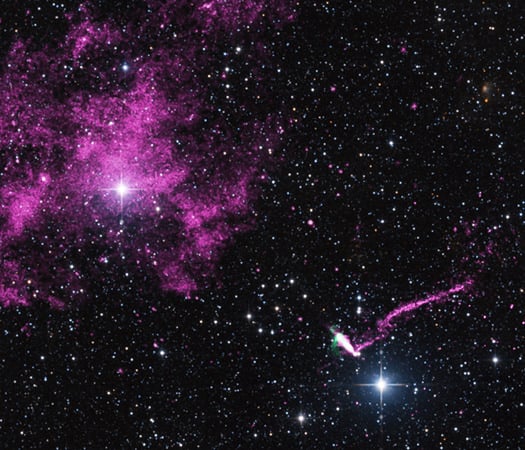One of the fastest-moving pulsars ever observed is spewing out a record-breaking jet of high-energy particles that stretches 37 light years in length – the longest object in the Milky Way galaxy.
"We've never seen an object that moves this fast and also produces a jet," said Lucia Pavan of the University of Geneva in Switzerland and lead author of
a paper analyzing the object
. "By comparison, this jet is almost 10 times longer than the distance between the sun and our nearest star."
The pulsar, a type of neutron star, is has the official moniker of IGR J11014-6103, but is also known as the "Lighthouse nebula." Astronomers say the pulsar's corkscrew-like trajectory can likely be traced back to its birth in the collapse and subsequent explosion of a massive star. The curly-cue pattern in the trail suggests the pulsar is wobbling like a spinning top.
The team says that their findings suggest that "jets are common to rotation-powered pulsars, and demonstrate that supernovae can impart high kick velocities to misaligned spinning neutron stars, possibly through distinct, exotic, core-collapse mechanisms."
The object was first seen by the European Space Agency satellite INTEGRAL. The pulsar is located about 60 light-years away from the center of the supernova remnant SNR MSH 11-61A in the constellation of Carina. Its implied speed is between 4 – 8 million km/hr (2.5 million and 5 million mph), making it one of the fastest pulsars ever observed.
IGR J11014-6103 also is producing a cocoon of high-energy particles that enshrouds and trails behind it in a comet-like tail. This structure, called a pulsar wind nebula, has been observed before, but the Chandra data show the long jet and the pulsar wind nebula are almost perpendicular to one another.
Usually, the spin axis and jets of a pulsar point in the same direction as they are moving.
"We can see this pulsar is moving directly away from the center of the supernova remnant based on the shape and direction of the pulsar wind nebula," said co-author Pol Bordas, from the University of Tuebingen in Germany. "The question is, why is the jet pointing off in this other direction?"
One possibility requires an extremely fast rotation speed for the iron core of the star that exploded. A problem with this scenario is that such fast speeds are not commonly expected to be achievable.
"With the pulsar moving one way and the jet going another, this gives us clues that exotic physics can occur when some stars collapse," said co-author Gerd Puehlhofer also of the University of Tuebingen.
Read the team's paper.
Source:
Chandra
 Universe Today
Universe Today
